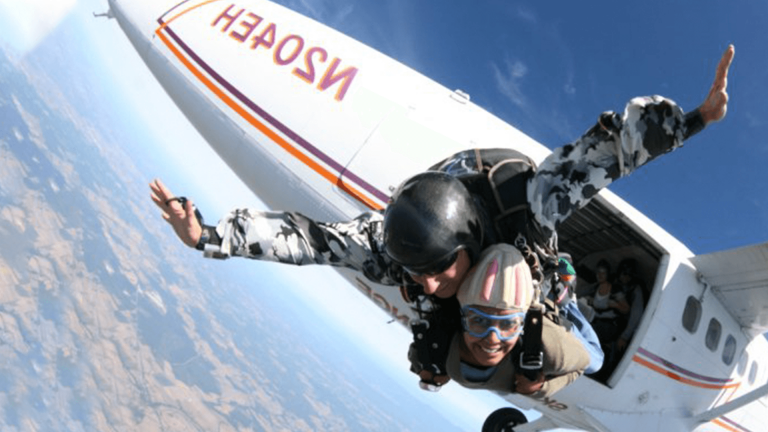You’re more than 3.6 km (12,000 ft) above the Earth. And there’s no turning back now.
But as you jump out of the plane, and see how beautiful the Earth looks below you, you start to think that this might not be so bad. Then you pull the cord to open your parachute, and all your worst fears come true.
There’s no parachute coming out, and now you’re plummeting towards the ground at about 200 km/h (125 mph). You’ve only got about a minute before you hit the ground. Is there anything you can do to save yourself?
Here’s how to survive a fall without a parachute.
Every time your life depends on a parachute, there is a one in 1,000 chance that it won’t work. But a malfunctioning parachute isn’t necessarily a death sentence.
According to skydiving experts, the secret to surviving is all about how you react when the parachute fails. How should you position your body? Is there anything you could do to slow down your fall? And why could landing on a roof be better than landing in a big body of water?
Step 1: Slow Your Descent
Just like most survival situations, the best thing to do is to slow everything down. Slow down your breathing to avoid hyperventilating, slow down your thoughts so you can focus, and slow down the speed of your fall so you don’t splatter on the ground.
To do that, you’ll need to spread out your body into an x-shape. Spread your arms and legs, point your chest toward the ground, and arch your back and head upward. This will create more air resistance, and slow your acceleration, giving you time to choose where to land.
Step 2: Avoid Landing in Water
Although the giant pool of liquid below you might look like a more appealing landing spot than the solid ground, it would probably be just as deadly. Like concrete, water doesn’t compress, so landing in a lake would be just like landing on a sidewalk.
Sure, you could position yourself to reduce the impact, but even then you could still be knocked out cold. And being unconscious underwater does not help you survive, so let’s find somewhere better.
Step 3: Direct Yourself to a Better Landing Spot
To move sideways through the air, away from the water, and towards a safer target, you’ll need to use a skydiving technique called tracking. Bring your arms and legs in against your body to steer it as you fall.
Your three best options for landing spots would be a swamp, snow, or trees, because they would all extend your deceleration time and help you slow down. If you were to land on solid ground, your body would decelerate from its falling speed of 200 km/h (125 mph) to 0 km/h in half a second, hitting you with enough g-force to kill you instantly.
But if you were to land somewhere that provides more cushioning, you could extend that deceleration by a couple of seconds, which would significantly reduce the g-force, and give you a better chance of surviving. If you can’t see a swamp, snow, or trees anywhere nearby, then your next best option would be to look for something big to break your fall, like a rooftop, or a bus. These structures are not very strong, so when you hit them, they’ll break and absorb some of the energy of your fall.
Step 4: Land on Your Feet
Okay, so now it’s the moment of truth. You’ve chosen your target landing spot, and now you’ve got to hit it. The best way to do this would be to point your toes toward the ground, and land on the balls of your feet. I know what you’re thinking. “That sounds painful!” And you’re right, it will be.
But the idea is that your body will have more time to slow down if you land feet-first. The long bones in your legs will absorb a large amount of the impact energy before they fracture. Essentially, you’ll be sacrificing your legs to protect the rest of your body.
Step 5: Cover Your Head
Just before landing, put your head down, with the fingers of each hand locked together behind it, and point your elbows in front of your face, to protect your head and neck from impact. The main reason why people die from falling off tall buildings and bridges is severe head trauma.
Even if you do everything else right, if you end up bouncing on your head when you land, you won’t survive.
So quickly, get into position. That should be all you need to know. Now comes the hard part. You need to figure out where you are, and get help as soon as possible.
Subscribe to What-If on YouTube or follow the show on Facebook Watch.
Sources
- “How To Survive A 10,000-Foot Fall”. 2020. npr.org.
- “What if you fell out of an airplane without a parachute?”. Howstuffworks.
- “How to Fall 35,000 Feet And Survive”. 2010. Popular Mechanics.
- “How to Fall 15,000 Feet, Hit the Ground, and Survive”. 2016. Vice.
- “How Common Are Skydiving Accidents?”. 2020. Seeker.


















